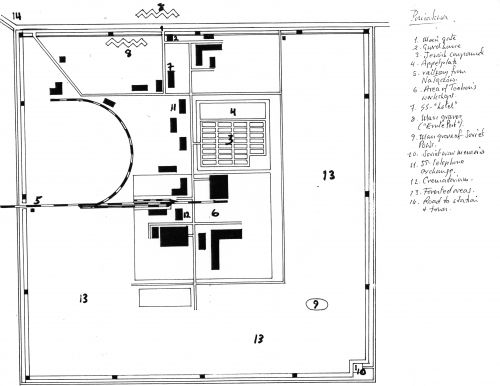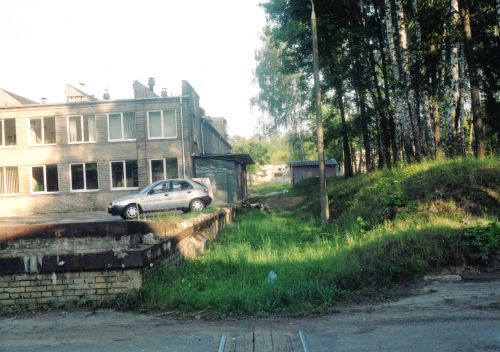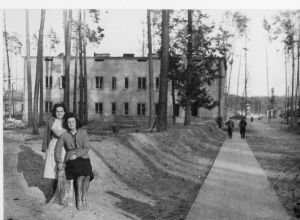Poniatowa Labour Camp
Poniatowa-
Poniatowa is located about 25 miles to the west of Lublin. At the end of the 1930’s, shortly before the outbreak of the Second World War, the Polish government had planned a telephone and telegraph centre in Poniatowa, which was never completed. In July 1942, Amon Göth, who was part of Odilo Globocnik’s Aktion Reinhardt staff in Lublin, inspected Poniatowa and recommended it as a site to hold Jewish labour, a proposal that was followed by Heinrich Himmler when, on 9 October 1942, he issued an order to concentrate all Jewish labour working in the armaments sector in camps under SS administration in the Warsaw –Lublin area. Poniatowa was one of the chosen locations because it was deeply hidden in the forests and had buildings already available and with a light railway connection to Naleczow, a station on the Warsaw –Lublin line. The Schmidt-
On 9 January 1943, Himmler directed the Higher SS and Police Leader of the General Gouvernement Friedrich – Wilhem Krüger, to transfer the Jews and businesses from the Warsaw ghetto to the Lublin area. Himmler was exasperated about the enormous profit that individual employers such as Bremen coffee wholesaler Walter Caspar Toebbens were making from the exploitation of more than 20,000 Jews in the Warsaw ghetto. Toebbens was directed to immediately transfer his labour force to Poniatowa and to transfer direct supervision to the SS. At the end of January 1943, Toebbens concluded a contract with Odilo Globocnik, the SS and Police Leader Lublin, under which the SS assured him the supply of at least 10,000 Jewish workers. At the end of February 1943, the first group of Toebbens Jewish workers were sent from the Warsaw ghetto to Poniatowa, another 1,200 followed on 12 March 1943, and a further 450 in April 1943. The last transport arrived in Poniatowa on 8 May 1943. All the prisoners arrived at the Naleczow railway station, where they put on narrow gauge railway trains that took them to Poniatowa. A labour detachment was based in Naleczow to load and unload the trains.
The arrival of the Jews from Warsaw, some of whom travelled as family units, and this gave the camp its own unique structure, men and women mostly slept in the same barracks, and contact between them was largely allowed. Around 700 children lived in the Poniatowa camp. They had their own barracks and kitchen. The Poniatowa inmates wore their own clothes, however in the autumn of 1943, their shoes were replaced with the usual wooden concentration camp clogs. The workshops and accommodation barracks were fenced in with barbed wire. The prisoners slept in around 35 barracks, each about 35 meters long and 12 meters wide. More than 2,000 prisoners slept in the 80 meter long, 40 meters wide and 10 meter tall workshop number 3, in four-

Poniatowa Camp Drawing - (Mike Tregenza)
The number of prisoners in Poniatowa was approximately between 14,000 and 25,000 and Poniatowa was the largest Jewish labour camp in the General Gouvernement. Around 10,000 to 12,000 of the prisoners worked for the Toebbens company; the others under much less brutal conditions, worked for the SS, building roads and sewers. The prisoners in Poniatowa, came from across Europe, Poland, Czechoslovakia, Germany, Austria and the Soviet Union. In the summer of 1943, Jews were brought to Poniatowa from the dissolved ghettos in Demblin, Dorohucza and Smolensk. Between May and October 1943, the camp also functioned as a transit camp for Jews, who were needed by the SS to work in other locations. Until the summer of 1943, enclosure of the ‘settlement’ the camp security, and prisoners’ working conditions were relatively bearable. Prisoners repeatedly were able to escape, and those who had contact with the outside world were able to smuggle food into the camp. It was only with Globocnik’s visit in June 1943 that the camp was sealed and the exploitation of prisoners intensified. There were several reported cases of resistance: the Jews from Opole attempted to poison the camp commandant Hering. All of the members of the kitchen detachment, who were involved, including six women, were hanged once the assassination attempt was discovered. The Jews from Warsaw had their own resistance movement, which was based on organisational structures and contacts from their time in the ghetto, aimed to free the inmates at the time the camp was liquidated.
The prisoners’ day began with a roll call at 6.00 a.m. and between 7.00 a.m. and 5.00 p.m. most of the prisoners manufactured products for the Wehrmacht. Globocnik reported in the summer of 1943 that each week the Poniatowa SS Labour Camp produced 38,000 blouses and coats, 18,000 shirts and items of underwear, 6,000 caps, 7,200 pairs of socks, 4,200 haversacks, and 2,400 army kit belts. The prisoners also worked at a sorting station, sorting the clothes of murdered Jews for dispatch to the Ethnic German Liaison Office (VOMI). In September – October 1943, hundreds of prisoners were deported to work at the airfields at Zamosc and Biala Podlaska. In the summer of 1943, Toebbens had made contact with the Armaments Ministry in Berlin, requesting new work orders. As a result, in September 1943, the prisoners who lived in workstation 3 were moved out, and the building was prepared for metal processing machines. At the same time, there began massive construction work for a planned, but ultimately unrealised relocation of part of the Litzmannstadt (Lodz) ghetto production facilities to Poniatowa. 48 accommodation and 28 barracks for foremen were planned to be built. However, with the transfer of Odilo Globocnik from Lublin to Trieste, and the appointment of Jakob Sporrenberg, as SSPF Lublin, meant that these plans did not come to fruition.

Ramp at Poniatowa 2004 - (Chris Webb Archive)
During September – October 1943, the SS Business Administration Main Office (WVHA), took over the labour camp, and Poniatowa was now regarded as a sub-
The Poniatowa camp continued to function with 100 prisoners who had been brought from the Lublin concentration camp, under SS and Ukrainian-
SOURCES:
The Encyclopaedia of Camps and Ghettos 1933-
Photograph: Wiener Library, London and Chris Webb Archive
Drawing - Mike Tregenza
© Holocaust Historical Society 2019


